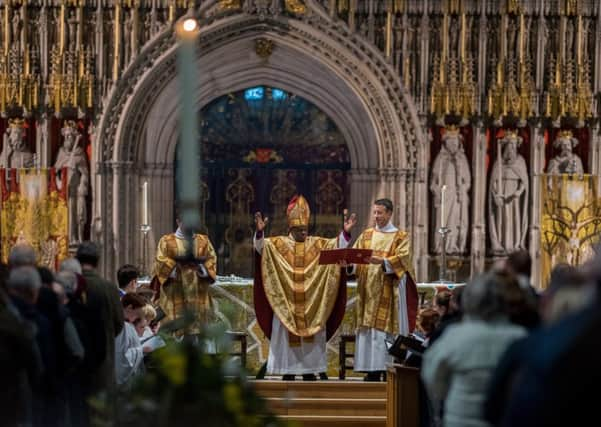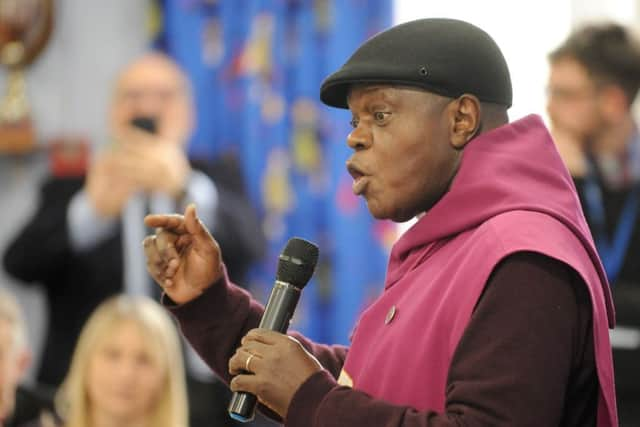The Archbishop of York: How we can find hope and love in a twisted world this Easter


Her mouth was twisted after a tiny nerve had been severed during the operation. It would be permanent. Selzer had saved her life by removing a tumour in her cheek and there had been no choice but to cut the nerve.
Her young husband also stood at the bed gazing at his wife as she absorbed the news that her face would always sit in this new, twisted, broken shape.
“I like it,” he says. “It is kind of cute.


Advertisement
Hide AdAdvertisement
Hide Ad“All at once I know who He is. I understand and I lower my gaze.
“One is not bold in an encounter with a God. Unmindful, he bends to kiss her crooked mouth and I am so close I can see how he twists his own lips to accommodate to hers, to show her that their kiss still works.”
Christians call today Good Friday while we remember a series of events that seem the very opposite of good.
The God man twisted on a cross and dying. The murder of an innocent man. The triumph of political and religious power over a humble revolutionary. Where is the good in this Friday?
As Cher sang: “It’s in his kiss!”
Advertisement
Hide AdAdvertisement
Hide AdAll around us we see a breath-taking world but also one that is wanting and twisted out of shape.
Rising temperatures, floating plastic and dying species scar our Earth – let alone pollutions of all sorts!
We see our glorious Yorkshire with its incomparable history and irresistible geography.
But we also see divided communities, lonely people, violent crime and poverty.
Advertisement
Hide AdAdvertisement
Hide AdWe see those we love, people we are proud to call family and friends but we also see broken hearts and promises, illness and anxiety.
Closest to home, if we are brave enough to look at ourselves, perhaps we dare to see our own mixture of joy and sadness, hope and fear, good intentions and disguised self-centeredness.
As Aleksandr Solzhenitsyn, the Russian novelist and historian, wrote: “The line separating good and evil passes not through states, nor between classes, nor between political parties either – but right through every human heart – and through all human hearts.”
It’s in his kiss.
Today we remember that God was not willing to walk away or keep a distance from the broken world he loves.
Advertisement
Hide AdAdvertisement
Hide AdInstead he stooped down, became part of it and one of us. As his body hung dying he was twisted into the ultimate kiss.
In 2004 the remains of more than 80 Romans, most of whom had been decapitated, were found at Driffield Terrace in York.
They became the mystery of York’s headless Romans – who were they, and why had they been killed in that way?
A decade later researchers at the University of York, as part of an international team, used the latest technology in efforts to solve the mystery.
Advertisement
Hide AdAdvertisement
Hide AdIt seems likely that the skeletons belonged to gladiators – though they may have been soldiers or criminals.
Genome technology showed that most were of British or European origin. One however had a very different story.
Analysis of his remains showed that he grew up in the Middle East, perhaps Palestine, Jordan or Syria. Then for some reason he travelled to York where he met his death.
Many questions remain and the mystery continues. Why did he come here? Why was he executed by the sword? We don’t know.
Advertisement
Hide AdAdvertisement
Hide AdBut we do know that in other places the Romans devised a slower, more painful and humiliating way to kill their enemies and worst criminals. That was crucifixion and it was used on thousands of their enemies and those they wished to punish in the most public way.
Many were victims of injustice. But one was different. His mother was Mary and his father was God. He came from heaven via Bethlehem. And he was innocent not just of any crime, but of any selfishness or sin. His death had been foretold by Prophets centuries before and he chose to go through with it for me and for you.
We are so used to seeing the cross on churches and on people’s jewellery that we easily forget just how shocking that is.
Imagine if when I baptise new Christians this weekend, as I do every year, there is a large statue of an electric chair next to the baptism pool or I wear one on a chain around my neck!
Advertisement
Hide AdAdvertisement
Hide AdIt would be strange, shocking, offensive even. But that is the meaning. Good Friday focuses on a cross. A carefully cruel means of execution, twisting the victim in agony as they die.
And then one day it was God the Son they twisted and killed. Jesus, the God-Man, twisted and broken into his kiss of love for his twisted, hurting world created as paradise.
But it was more than the greatest kiss of love, it was also the eternal kiss of life. He didn’t just become like us as he died, he opened the way for us to become like him as he rose from death to life. He didn’t just twist himself in his death to fit our brokenness, he untwisted evil, sin and death, opening for us a new way into life and a hope that has no expiry date.
When our news is frightening and our world is confusing, remember that there is hope because beyond Good Friday lies Easter Sunday.
Advertisement
Hide AdAdvertisement
Hide AdWhen our best efforts fail or our dreams seem to disappear, remember that there is hope because beyond Good Friday lies Easter Sunday.
When we are lonely or alone, fearful or sad, angry or in despair, remember that there is hope because beyond Good Friday lies Easter Sunday.
His kiss of love and his kiss of life. It’s in his kiss.
Dr John Sentamu is the Archbishop of York.